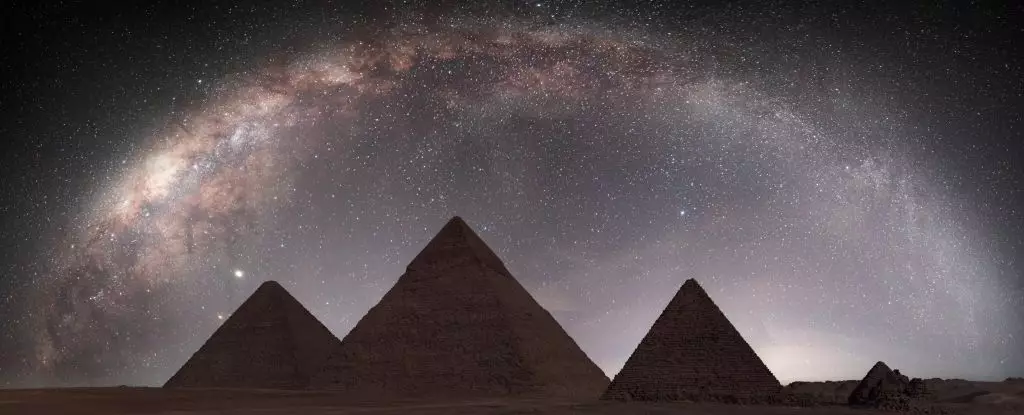The profound mysteries of ancient civilizations have always captivated scholars and laypeople alike, constantly inviting fresh perspectives. Recent investigations into the intersection of art and astronomy have unveiled tantalizing insights, particularly regarding the ancient Egyptian goddess Nut. Through the lens of modern astrophysics, Or Graur’s meticulous study reveals that Nut may not merely exist as a mythological figure; rather, she could encapsulate a cosmic phenomenon directly visible in our night sky—the Milky Way. This innovative discussion encourages us to reevaluate our understanding of both history and celestial narratives, raising critical questions about how ancient peoples perceived their universe.
Graur’s research reveals that depictions of Nut, adorned with cosmic objects, are often found in funerary art. The goddess is typically illustrated in a protective pose, suggesting a deep connection to life after death while simultaneously reinforcing her role as a cosmic guardian. By analyzing numerous coffin artworks dating back thousands of years, Graur provides convincing evidence that these ancient Egyptians might have encoded their observations of the heavenly Milky Way into their funerary traditions.
Art as a Reflection of Cosmic Understanding
On close examination of coffin artwork, Graur discovered a particularly striking feature in one depiction—a flowing, undulating line that may represent the Milky Way’s Great Rift, the dark band of dust interlaced amid the cascading light of stars. This correlation presents an intriguing argument that ancient Egyptians may have intuitively captured astronomical realities in their artistic expressions. Such interpretations prompt a broader investigation into the fabric of Egyptian cosmology, where the boundaries between spirituality and science were likely porous, influencing each other in intricate ways.
The goddess Nut, portrayed as a majestic figure with a body adorned by cosmic elements, suggests more than artistic license; it reflects a tangible cosmological understanding unique to these ancient peoples. Graur’s research, drawing upon ancient texts and analyzing various artworks, illustrates how mythology and astronomy intertwined in a manner that feels astoundingly relevant even today. The potential representation of the Milky Way in Nut’s form speaks to a shared human curiosity about the cosmos, transcending time and culture.
Rarity and Significance of the Cosmic Depiction
One of the most compelling aspects of Graur’s investigation is the rarity of the cosmic representation across different artifacts. While examples of Nut appearing adorned with cosmic symbols abound, the specific depiction featuring the undulating curve that may signify the Milky Way is markedly rare. Graur emphasizes that this uniqueness signifies a deliberate artistic choice, not a mere embellishment. The infrequent portrayal supports the contention that this cosmic vision held particular significance, perhaps indicating a heightened spiritual or scientific understanding of the Milky Way during that era.
Such rare instances invite further inquiry into the cultural context of ancient Egypt and the specific meanings imbued in different representations of Nut. They challenge us to consider how closely ancient Egyptians aligned their spiritual beliefs with their observations of the night sky. Graur’s assertion that Nut is not synonymous with the Milky Way, but rather, that the cosmic phenomena serve to decorate her body, expands our understanding of their cosmological framework. This nuanced perspective asserts the vibrancy of ancient Egyptian thought, which navigated between mythology and celestial science.
Interdisciplinary Collaboration: A Key to New Discoveries
Graur’s work is a superb illustration of the importance of interdisciplinary research, blending the wisdom of astronomy with the artistry of ancient cultures. The merging of astrophysics and archaeology in this study illustrates how different fields can synergistically enhance our understanding of human history. By fusing new scientific insights with ancient artifacts, we can appreciate not only the technical but also the artistic mastery of ancient peoples.
Moreover, Graur’s research underlines the necessity for greater access to cultural and scientific resources. The importance of digitizing archive materials to promote exploration and scholarship in the humanities cannot be overstated. As we enhance access to museum catalogs and ancient texts, we invite a diverse audience to engage in dialogue—an essential component for uncovering our shared human heritage.
The cosmos has always held a profound fascination for humanity, and perspectives like Graur’s provide a vibrant avenue through which to appreciate the vast complexities of ancient thought. As we navigate through the threads connecting ancient myths and cosmic truths, we not only discover the richness of cultures long past but also reflect on our ongoing quest to comprehend the universe that surrounds us.

